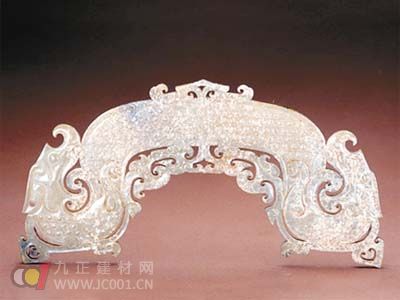Chinese ancient jade category:
Chinese ancient jade articles can be roughly divided into eight categories: ritual instruments, ceremonial devices, funeral devices, accessories, tools, household appliances, furnishings, and miscellaneous devices. In these kinds of jade articles, except for the variety of jade rituals that have changed little over the past few thousand years, other types have changed in varieties from time to time.
Ritual music : Some utensils used in ceremonial activities such as rituals, pilgrimages, appointments, military services, etc., have been given a special meaning, the so-called rituals.
Some jade articles were still important rituals until the late Qing Dynasty. According to "Zhou Li. Da Zongbo" contains: "Jade as a six-piece, to the heavens and the earth, to the heavens and the earth, to the yellow rites, to the Qing dynasty to the east, to the south, to the white tiger, the West, Take Xuanzang to the north. "The wall, pipa, gui, ç’‹, ç’œ, six kinds of jade, is the so-called ritual instrument. In addition, ç‘—, ring, ç‘, etc. have also been rituals in different periods.
Yilong class : also known as jade weapons, mainly Yuge, jade knife, jade, jade, gums, jade axe and so on.
These shapes are originally derived from the utility, mainly in the commercial and weekly generations, and are most prominent in the pre-business period. In the Spring and Autumn Period and the Warring States Period, except for a small number of works in antique jade, these artifacts are rarely seen. Most of them have no trace of use, but mainly for the instrument.

Funeral class : referred to as funeral jade.
Because of the influence of ghosts and gods and religious thoughts, people in ancient times believed that after death, the soul would go to another world. For the sake of the soul to live forever, people think that jade can protect the body of the deceased. From the time of the Warring States period, a system of funeral jade was gradually formed. The jade is buried here, which refers to the burial jade that was made to preserve the body. The main sights of the buried jade used in history (including masks, eye curtains and eyebrows), jade, jade, jade, jade and so on.
Perfume: refers to the personal jade, its content is very complex, mainly headgear, earrings, ornaments, ornaments, body ornaments, jade ornaments from the original society.
Many of the smaller plate-shaped bodies, the body of the body with perforated objects are considered to be decorative, mainly: jade, jade, jade, jade, jade, jade and various jade, jade pendant and so on.
Production tools: mainly found in the Neolithic Age and the Bronze Age.
With the prosperity of the bronze smelting industry and the emergence of ironware, the production tools made of jade materials gradually disappeared. Jade tools have axe, arrow, cymbal, jin, chisel, knife, etc., and there is no difference between the shape of the bronze tool. A large number of jade tools were unearthed at the Yinxu Women's Tomb, the Sanxingdui Sacrifice Pit, and the Jiangxi Xingan Tomb.
Living utensils : jade utensils. First seen in the Shang Dynasty, which is jade.
In the Qin and Han dynasties, the Yujiao Cup, the Yuxi, the Jade, the Jade, and the Yu Yu were also common. After the Tang and Song Dynasties, jade cups, jade bowls, and jade bottles appeared in large numbers, and the variety of tableware, stationery, and wine utensils soared. Antique jadeware began to be produced thereafter. In the Qing Dynasty, the variety and quantity of jadeware reached its peak. The jade articles of the living utensils may also become funeral jade articles because of the funeral.
Furnishing categories: mainly Yushanzi, Yupingfeng, jade beasts and other artifacts, most seen in the Qing Dynasty.
During the Shang and Zhou Dynasties, some small round jade carvings without perforations may also be jade furnishings. Some antique jadeware is also used for furnishings. In addition, stationery appliances, such as pen holders, book towns, and pen holders, are made of jade. (8) Refers to utensils that cannot be classified into the above categories. The more common ones are hooks, wishful, sturdy, sturdy, jade, jade and so on. In the course of thousands of years of development of Chinese traditional jade articles, the vast majority have evolved with the changes of the times. No matter a variety or a shape, only a few are relatively stable.
Stainless Steel Wire Mesh,Stainless Steel Perforated Metal Mesh,Expanded Stainless Steel Wire Mesh
Kaian Metal Wire Mesh Co., Ltd. , http://www.hsweldedmesh.com